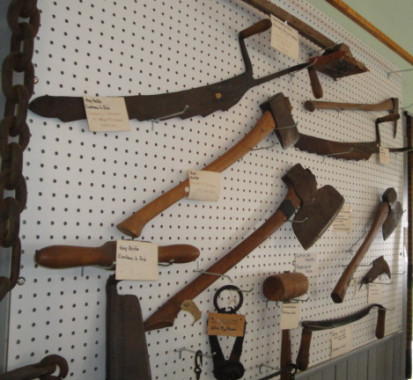3-Hand_Tools.jpg

Carpentry Hand Tools.
Clockwise from top right: log scaler, hay knife, broad axe (used to square timber), hatchel, draw knife (to work wood), hand sander for floors, hay knife, axe, broad axe, wire tightener, wooden hammer, hay knife, scale, bridle chain (brakes on a sleigh when going down a steep hill). The chisel-edged broad axe was a particularly essential tool for the early settlers. A kind of plane or striking chisel used for hewing round logs into square beams, it was twice the size of a felling axe and required two hands. One side of the axe was beveled. The most expert axe men could cut a beam with the fewest axe marks, spaced nicely along the beam. Another type of broad axe, with both sides beveled, was used to hew railroad ties.
(Compton County Museum Collection / Photo - Jackie Hyman)
Clockwise from top right: log scaler, hay knife, broad axe (used to square timber), hatchel, draw knife (to work wood), hand sander for floors, hay knife, axe, broad axe, wire tightener, wooden hammer, hay knife, scale, bridle chain (brakes on a sleigh when going down a steep hill). The chisel-edged broad axe was a particularly essential tool for the early settlers. A kind of plane or striking chisel used for hewing round logs into square beams, it was twice the size of a felling axe and required two hands. One side of the axe was beveled. The most expert axe men could cut a beam with the fewest axe marks, spaced nicely along the beam. Another type of broad axe, with both sides beveled, was used to hew railroad ties.
(Compton County Museum Collection / Photo - Jackie Hyman)